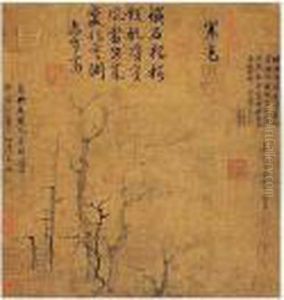Cao Zhibai Paintings
Cao Zhibai was a Chinese painter and calligrapher during the Yuan dynasty, which was governed by the Mongol Empire. Born in 1271, his life spanned a period of significant political and cultural transformation in China. Despite the challenges of living under non-Han Chinese rule, the Yuan period was a time when the arts flourished, and many intellectuals turned to the arts as a means of personal expression and cultural preservation.
Cao Zhibai was known for his landscape paintings and for his skill in calligraphy. His style was characterized by its simplicity, restraint, and a preference for monochromatic ink work, which were hallmarks of the literati painting tradition of the time. Literati, or scholar-officials, were the educated elite who were versed in poetry, painting, and calligraphy, and they often used these arts to express scholarly ideals and personal emotions.
Although specific details about Cao Zhibai's life are relatively scarce, it is known that he was associated with the scholarly and cultural circles of his time. His works would have been appreciated primarily within these circles, where the appreciation of art was tied to an understanding of the cultural and philosophical traditions of China, such as Confucianism, Taoism, and Buddhism.
Cao Zhibai's paintings often depicted natural scenes that were imbued with a sense of tranquility and philosophical depth. Mountains, water, mist, and trees were common motifs, rendered with expressive brushwork that sought to capture the spirit of the subject rather than its literal appearance. This approach was in keeping with the concept of 'qi yun sheng dong' (spirit resonance, life-motion), which was central to Chinese aesthetics.
After his death in 1355, Cao Zhibai's legacy continued through his influence on later generations of painters. His works were collected and emulated, contributing to the ongoing development of literati painting in China. Today, Cao Zhibai is remembered as one of the notable artists of the Yuan dynasty, and his paintings can be found in various museum collections, where they are studied and appreciated for their serene beauty and cultural significance.

